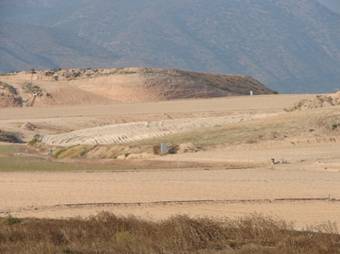Livelihood, migration, land conversion and land degradation
The main income for people in the rural areas of the Guadalentín basin is from agriculture. Traditionally this involves mainly dryland farming of cereals, almonds and olives in the rural headwaters and irrigated farming of horticulture in flat areas.
However, as was indicated before, important land use changes have taken place throughout history in the Guadalentín. In last decades important land abandonment of traditional dryland farming has occurred together with an increase of almond plantations and intensely irrigated horticulture.
Changes in the population are strongly related to changes in land use and to land degradation. On the one hand, high population pressure can cause land degradation, while on the other hand degraded areas with low productivities often show abandonment and low population growth resulting in land use changes. The Guadalentín basin has seen reduced population growth compared to the regional and national average, and the Guadalentín has more people in the age older than 65 years, and less people in the potentially active working population, compared to the regional and national average. Of the working population traditionally a relatively large part has been working in agriculture (close to 50% in the 1980s). However, this percentage has been rapidly decreasing since the 1960s to about 20% in the 1990s (Romero Diaz et al., 2002).
Migration of people from the rural areas to the cities, starting in the 1960s, has caused important land abandonment in the Guadalentín. This resulted in increased soil erosion rates and land degradation, since abandonment of cultivated fields often leads to the destruction of terraces, and in first years after abandonment also in higher erosion and runoff rates due to crust formation (Cerda, 1997). Consequently, there is a potential risk that contaminated sediments in terraces or in hollows are mobilised due to land use changes and land abandonment (Imeson et al., 1998).
Parallel to the abandonment of land, developments in the national, European and global economy have been an incentive to shift from dryland agriculture to irrigated crops where possible, and to almond orchards. The Murcia region is now one of the major exporters of lettuce, tomato, melons, peach and other fruits and vegetables. In order to prepare the land for large scale irrigated crop production, land levelling operations are currently taking place at a large scale (see photograph 2). Although it is evident that they will have important long-term effects, there is currently no clear view of the extent of these land use changes and on the exact type and quantities of its impact.
Photograph 2: Levelled land for lettuce plantation in the Torrealvilla catchment, August 2007 (Photo by J. de Vente).
In large parts of the Guadalentín reforestation was and is a widely applied conservation measure to combat land degradation. Previously, reforestation was performed on terraces constructed with heavy machinery. Various studies have indicated that in fact these reforestations are very ineffective and even increase runoff erosion rates (e.g. de Wit and Brouwer, 1998). Nowadays it is well accepted that the success of reforestations depends to a large extend on the local climatologic conditions such as effective annual rainfall. There is ongoing research on the effectiveness of reforestations and on the best species and planting techniques to be used in reforestations (e.g. Castillo et al., 2003; Bellot et al., 2004; Barbera et al., 2005; Boix-Fayos et al., 2007).
